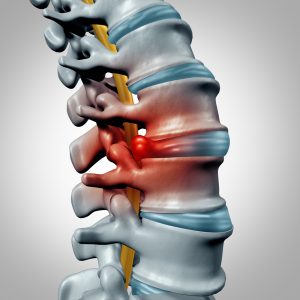Herniated Disc: 4 Factors That Indicate A Good Outcome
 One of the most common causes of low back pain is a herniated disc. The most common age bracket is between 30 and 50 years of age. Men are twice as likely to suffer a herniated disc as women. Along with back pain, a herniated disc can also cause pain or numbness down the leg.
One of the most common causes of low back pain is a herniated disc. The most common age bracket is between 30 and 50 years of age. Men are twice as likely to suffer a herniated disc as women. Along with back pain, a herniated disc can also cause pain or numbness down the leg.
A herniated disc happens when the jelly like center (nucleus) of a disc, squeezes out of the center and through the outer layers (annulus) of the disc. This jelly center can then put pressure on the nearby spinal nerve roots. This process the starts an acute inflammatory process that can also irritate the spinal joints and or nerve root.
While a herniated disc can be extremely painful, there are studies that show, given time, 88% of patients show a natural reduction of the disc herniation in 3-12 months. (1) This suggest if possible, with patient’s pain tolerance, time, coupled with conservative therapy there can be a successful resolution of the herniated disc.
Another study presents four factors found on an MRI, that aid in the determination of how well the body is able to reabsorb the herniated material over time. (2) These factors include:
- 1. Movement up or down the spinal canal of the herniated material.
- 2. A larger herniation of the nuclear material
- 3. How uniform the material of the herniation is
- 4. Inflammation or Degenerative changes of the spinal bones (vertebral body)
The process of the body being able to reabsorb the herniated material is based on the fluid content of the herniated material being broken down and reabsorbed the body’s natural inflammation process.
1. Movement up or down the spinal canal of the herniated material.
While the idea of the herniated material moving up or down the spinal canal may make it appear worse, it actually is a sign of hope. For the material to move, it must contain more fluid; thus it is more susceptible to the normal inflammatory resorption process.
2. A larger herniation of the nuclear material.
The larger the herniation, is typically an indicator of how much fluid it contains. Just like above, the more fluid, the more possibility of being reabsorbed.
3. How uniform the material of the herniation is
While much of the herniated material can be the jelly like substance of the nucleus, sometimes it may include cartilage fiber from the disc outer rings or pieces of degenerated bone from the edges of the spinal bones above and below the disc. The purer the herniated material, the more fluid it contains, and it is easier to be reabsorbed.
4. Inflammation or degenerative changes of the spinal bones
There is a process of degeneration of the edges of the spinal bones called Modic Changes. It is an inflammation of the edges of the bone or the body begins to fill the edges with fat. If these changes are present, when the herniated disc happens, the herniated material may contain material from the edges of the vertebra. Relates to point number 3 above.
If no Modic changes are noted on the MRI that is one factor in favor of resorption of the herniated disc.
What Else You Can Do
While you may be waiting for the herniated disc to reabsorb, you can help yourself along with chiropractic care. One study published in Journal of Manipulative and Physiological Therapeutics found that chiropractic adjustments were quite effective in relieving low back and leg pain from a herniated disc. This study demonstrated at 3 months post treatment, 90.5% of the patients were improved and 88% were improved at 1 year. (3)
Give us a call at (314) 731-4383 and find out what chiropractic can do for your herniated disc.
1. Takada, E., Takahashi, M., & Shimada, K. (2001). Natural history of lumbar disc hernia with radicular leg pain: Spontaneous MRI changes of the herniated mass and correlation with clinical outcome. Journal of Orthopaedic Surgery (Hong Kong), 9(1), 1–7
2. Autio, R. A., Karppinen, J., Niinimäki, J., Ojala, R., Kurunlahti, M., Haapea, M., et al. (2006). Determinants of spontaneous resorption of intervertebral disc herniations. Spine, 31(11), 1247–1252. doi:10.1097/01.brs.0000217681.83524.4a
3. Leemann S, Peterson CK, Schmid C, Anklin B, Humphreys BK. Outcomes of acute and chronic patients with magnetic resonance imaging-confirmed symptomatic lumbar disc herniations receiving high-velocity, low-amplitude, spinal manipulative therapy: a prospective observational cohort study with one-year follow-up. J Manipulative Physiol Ther. 2014 Mar-Apr;37(3):155-63. doi: 10.1016/j.jmpt.2013.12.011. Epub 2014 Mar 11. PMID: 24636109.
